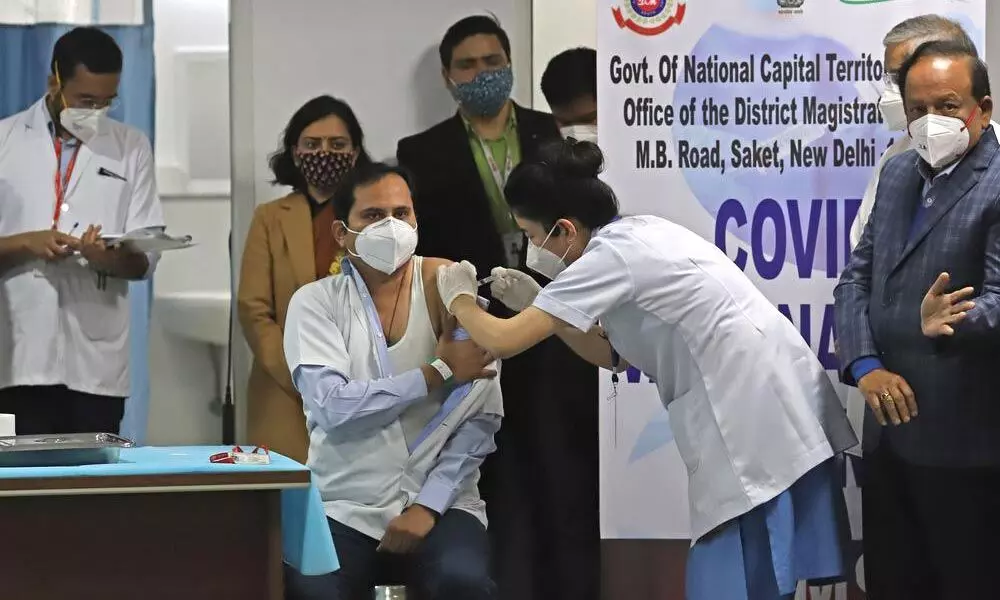V-shaped recovery on cards, but vaccine drive must succeed
Right now, the drive is slowing down owing to vaccine hesitancy even on the part of frontline healthcare workers. Doubts need to be cleared quickly by the government through a sustained communications campaign
image for illustrative purpose

Predictions are being made that India will not only bounce back from the trough, but will attain a high growth path in 2021
The green shoots of recovery that are being detected in the economy seem to have enthused global consulting agencies as well as the Reserve Bank of India. Predictions are now being made that India will not only bounce back from the trough into which it had fallen last year but will attain a high growth path in 2021. According to UK-based data analytics and consulting firm, Global Data, India will soon be back to its winning ways in the area of economic growth. It has even projected that it will once again become the fastest growing economy in the world, surpassing China, in 2021. The RBI has been more poetic, saying soon the winter of our discontent will be made glorious summer.
The data analytics firm has observed that India is expected to have a growth rate of 9.7 per cent in 2021, exceeding other major economies like China which is expected to grow by 8.65 per cent. It has pegged growth for the US at 3.96 per cent, the UK at 5.46 per cent and France at 6.23 per cent. Giving reasons for its assessment, it says the easing of restrictions along with huge fiscal stimulus from the government led to marginally better performance of the purchasing managers index for manufacturing and services since August last year.
It has to be said that even the International Monetary Fund (IMF) earlier made a similar projection. In its last World Economic Outlook, it predicted that India will make a strong recovery in 2021 with 8.8 per cent growth as against 8.2 per cent for China.
It is no doubt true that all indicators are pointing to a V-shaped recovery for the Indian economy. The latest news that daily power demand during the current month has crossed the highest level reached in January 2020 is yet another signal of reviving industrial and commercial activities. This is encouraging especially as factory output had fallen marginally in December after growing by 1.8 per cent in November last year.
These are all positive signs but it must be cautioned that growth numbers during the current year will be on the low base of 2020. Hence even a sharp rebound would really mean the economy is simply reverting to its pre-Covid status. And that, it must be recalled, was a situation of slow growth. Overall GDP growth was only 4.2 per cent in 2019-20. Even in the previous fiscal, growth had slowed down to 6.1 per cent, from 7.2 per cent and 8.2 per cent in the preceding two financial years.
So the question must be asked, if all indicators are pointing towards the economy moving back to pre-Covid levels, does this mean a return to the slow growth period of 2019-20. The deceleration of the economy over the past four years has been pushed to the background in the wake of the pandemic and the contraction in growth over the past ten months. Any measures for economic revival must keep this in perspective.
The process of slowing down economic growth began with demonetisation in 2016 and deepened with the launch of the Goods and Services Tax in the following year. The GST was a long-awaited tax reform but was implemented initially with a great deal of associated red tape, making it difficult for small businesses to fulfil all the processes needed to become a part of the GST system. Numerous levels of taxation created further confusion among trade and industry. GST was originally meant to be a single tax system, but the inter-state GST Council could ultimately only agree on a multi-level tax framework. The GST system was gradually streamlined but the time involved in doing so led to commercial operations being affected all over the country especially for small businesses.
As for the current recovery phase, it was given a boost with demand rising sharply in the festival season in November. The index of industrial production finally began to go up from the period from October to December. Power generation and petroleum consumption have also reached higher than pre-Covid levels. To be realistic, however, growth parameters really need to be compared with 2019-20 data rather than the trough year of 2020-21.
One of the major factors cited by the British data analytics firm in support of its prediction of high growth in 2021, is the decline in Covid cases from mid-September onwards. It cited the recovery rate of 96.5 per cent and low fatality rate of 1.4 per cent of cases. The launch of the mass vaccination drive in mid-January was also mentioned as a major factor in support of revival in transportation, hospitality and entertainment sectors which have been in the doldrums.
It has rightly pointed to the crucial role of the vaccination drive in the country's economic recovery. Right now the drive is slowing down owing to vaccine hesitancy even on the part of frontline healthcare workers. Doubts need to be cleared quickly by the government through a sustained communications campaign. A V-shaped recovery looks imminent right now but it will be given a much bigger impetus if the country is able to succeed in the mass vaccination process and achieve herd immunity.

